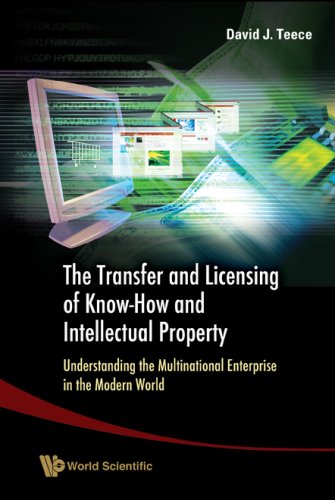

Most ebook files are in PDF format, so you can easily read them using various software such as Foxit Reader or directly on the Google Chrome browser.
Some ebook files are released by publishers in other formats such as .awz, .mobi, .epub, .fb2, etc. You may need to install specific software to read these formats on mobile/PC, such as Calibre.
Please read the tutorial at this link: https://ebookbell.com/faq
We offer FREE conversion to the popular formats you request; however, this may take some time. Therefore, right after payment, please email us, and we will try to provide the service as quickly as possible.
For some exceptional file formats or broken links (if any), please refrain from opening any disputes. Instead, email us first, and we will try to assist within a maximum of 6 hours.
EbookBell Team

4.7
106 reviews
ISBN 13: 9789812568496
Author: Teece David J
The international transfer of technology is one of the most important features of the global economy. However, the literature on it is sparse. This book encapsulates the author's contributions to this field over the last three decades and provides insights into the manner, mechanisms, and cost of technology transfer across national boundaries and the implications for (the theory of) the international firm.
Part I: International Technology Transfer
Technology Transfer by Multinational Firms: The Resource Cost of Transferring Technological Know-How
I. Introduction
II. Technology Transfer and the Production of Knowledge
III. The Sample
IV. Definition of Technology Transfer Costs
V. Transfer Costs: Data and Hypotheses
VI. Determinants of the Cost of International Technology Transfer: Tests and Results
VII. Differences Between International and Domestic Technology Transfer
VIII. Conclusion
References
Time-Cost Tradeoffs: Elasticity Estimates and Determinants for International Technology Transfer
Introduction
Foundations of the Time-Cost Tradeoff
Estimation of the Time-Cost Tradeoff
Determinants of the Elasticity of Cost with Respect to Time
Conclusion
References
The Market for Know-How and the Efficient International Transfer of Technology – David J. Teece
Codification and Transfer Costs
Characteristics of the Market for Know-How
Codes of Conduct and the Regulation of Technology Imports
Regulation of Technology Exports
Conclusion
Technology and Technology Transfer: Mansfieldian Inspirations and Subsequent Developments – David J. Teece
Introduction
Mansfield's Vision and Early Work
The Economics of (International) Technology Transfer
Summarizing Elements of Received Wisdom on Replication and Transfer
Capturing Value from Intellectual Capital
Valuation Issues: Accounting and Market Metrics
The Multinational Firm, Internalization, and R&D Activity
Closing
Acknowledgment, Notes, References
Part II: Licensing and Cross-Licensing
Profiting from Technological Innovation: Implications for Integration, Collaboration, Licensing and R&D Strategy
Introduction
The Phenomenon
Profiting from Innovation: Basic Building Blocks
3.1. Regimes of Appropriability
3.2. Dominant Design Paradigm
3.3. Complementary Assets
Implications for Profitability
4.1. Tight Appropriability
4.2. Weak Appropriability
Channel Strategy Issues
5.1.–5.5. Modes and Case Studies
Implications for R&D, Industry Structure, Trade Policy
Conclusion
References
Managing Intellectual Capital: Licensing and Cross-Licensing in Semiconductors and Electronics
RCA and AT&T
IBM and TI
Hewlett-Packard
Industry Comparisons and Policy Issues
Notes
Patents, Licensing, and Entrepreneurship: Effectuating Innovation in Multi-Invention Contexts
Introduction
IP and Entrepreneurship
Multi-Invention Context
Patent Strategy
Case Studies (e.g., SoC, Kentron)
Conclusion
Notes, References
Royalties, Evolving Patent Rights, and the Value of Innovation – Edward F. Sherry, David J. Teece
Value and IP Stages
Estimating Value
Quantifying Adjustment
Implications
Acknowledgments, References
Standards Setting and Antitrust – David J. Teece, Edward F. Sherry
I–V. Standards, Antitrust, SSOs, IP Rules, Policy Implications
Conclusion, Appendix
A Primer on Trademarks and Trademark Valuation – Michaelyn Corbett, Mohan Rao, David J. Teece
Trademark Definitions, Valuation Methods, Internet and Licensing
Conclusion
Notes, References
Part III: Organizing Research and Development
Firm Organization, Industrial Structure, and Technological Innovation – David J. Teece
Introduction
Characteristics of Technological Development
Organizational Determinants
Governance Archetypes
Matching Innovation and Organization
Conclusion
Overseas R&D by US-Based Firms – Edwin Mansfield, David J. Teece, Anthony Romeo
I–V. Trends, Scale, Cost, and Nature of Overseas R&D
Acknowledgments, Notes, References
Inter-organizational Requirements of the Innovation Process – David J. Teece
Models (Serial, Parallel)
Linkages (University, Vertical, Horizontal)
Implications: Cooperation vs. Integration
Conclusions, Notes
Strategic Alliances and Industrial Research – David C. Mowery, David J. Teece
Sourcing, Consortia, University Collaboration
Conclusion, Notes
Organizing for Innovation: When is Virtual Virtuous? – Henry W. Chesbrough, David J. Teece
Innovation and Virtual Firms
Industry Standards
Organizational Fit
Mitigating Procurement Hazards in Innovation – John M. de Figueiredo, David J. Teece
Technological Hazards, Safeguards
Integration, Credible Commitment
Conclusion
Part IV: The Multinational Enterprise
Technology Transfer and R&D of Multinational Firms: Theory and Evidence – David J. Teece
I–V. Theory, R&D, Development, Technique Choice
Acknowledgment, Notes
The Multinational Enterprise: Market Failure and Market Power – David J. Teece
Market vs. Hierarchy
Anticompetitive Risks
Evaluation
Multinational Enterprise, Internal Governance, and Industrial Organization – David J. Teece
Monopoly vs. Efficiency
Host-Country Controls
Dynamic Factors
Transactions Cost Economics and the Multinational Enterprise: A Reassessment – David J. Teece
Transactions Cost Perspective
Horizontal vs. Vertical Integration
Export Competitiveness
Host Country Relations
Dynamic Capabilities and the Multinational Enterprise: Penrosean Insights and Omissions – Mie Augier, David J. Teece
Abstract and Key Results
the transfer and licensing of creative works
knowledge transfer technology
explain the relationship between trademarks and licensing
university licensing agreement
is know how an intellectual property rights
Tags: Teece David J, Transfer, Licensing